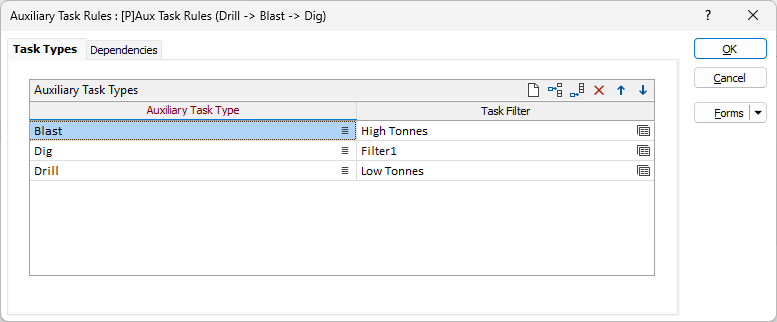Auxiliary Tasks
An operational schedule will almost always comprise multiple activities. All of these activities represent a component of the cycle of extracting a "mining block" and therefore must be incorporated into the schedule.
In mine scheduling, the excavation of material is considered as the "primary", or "parent", task. Other activities which occur either before or after excavation (for example, drilling, blasting, clean up and backfill) may be referred to as "auxiliary" tasks.
Note that each auxiliary task type may be used with at most one primary task type: an auxiliary task type may not appear in the Auxiliary Task Rules for different primary task lines (an error dialog is shown if this condition is violated).
![]()
A typical Operational schedule will be composed of groups of activities that are repeated for all tasks of particular types. For example, tasks that mine material in an underground mine are likely to require drilling and blasting of that material to be completed beforehand, and cleaning and backfilling to be completed afterwards. In this scenario, the excavation task is referred to as the “primary” task, and the drilling, blasting, cleaning and backfilling tasks are referred to as the “auxiliary” tasks. The combination of the primary task with its auxiliary tasks is referred to as a “cycle” of tasks.
Primary Task Type
Select the primary task type to which a rule set will be applied. Alternatively, right-click in the response and select New Task Type to create a new type.
Filter
Optionally, identify which tasks to apply the rule set to by applying a filter. If no filter is specified, the rule set will be applied to all tasks of the primary task type.
Click the Forms button to load a filter that was previously saved as a form set. To edit a filter, right-click and select Edit or press F4. To create a filter, right-click and select New.
Description
For clarity, enter a short description for the list of primary tasks identified by the filter.
Auxiliary Task Rules
Click the Forms button to load a previously saved form set that contains the rules for generating auxiliary tasks for the primary task. To edit a filter, right-click and select Edit or press F4. To create a filter, right-click and select New. See: Auxiliary Task Rules
Recreate Auxiliary Tasks
When you open the Auxiliary Tasks form in order to create or manage auxiliary tasks, this check box is unselected by default.
You can select an option to recreate auxiliary tasks on the Scheduling | Schedule tab, in the Task Types group. See: Recreate Auxiliary Tasks

Template
The Template button is only available for Template Forms. Template Forms inherit saved or previously used values.
Click the Template button to select and open a saved form set template.
Load Template
Click the Load Template button to select and open a saved template to populate the fields of the form.
Save Template
Click the Save Template button to save the details of the current form as a template that can be loaded at a later time.
Manage
Click the Manage button to open the Template Forms manager which can be used to open, save, delete, import and export the template forms for your project.
Undo and Redo
Click Undo (CTRL + Z) to undo recent changes in the form. After an Undo, click Redo (CTRL + Y) to restore the last change that was undone.
Collapse
Collapse (roll-up) the form to preview a chart, or preview the results of an operation in Vizex, or obtain input values from Vizex, the Property Window, the File Editor, or the Plot Editor.